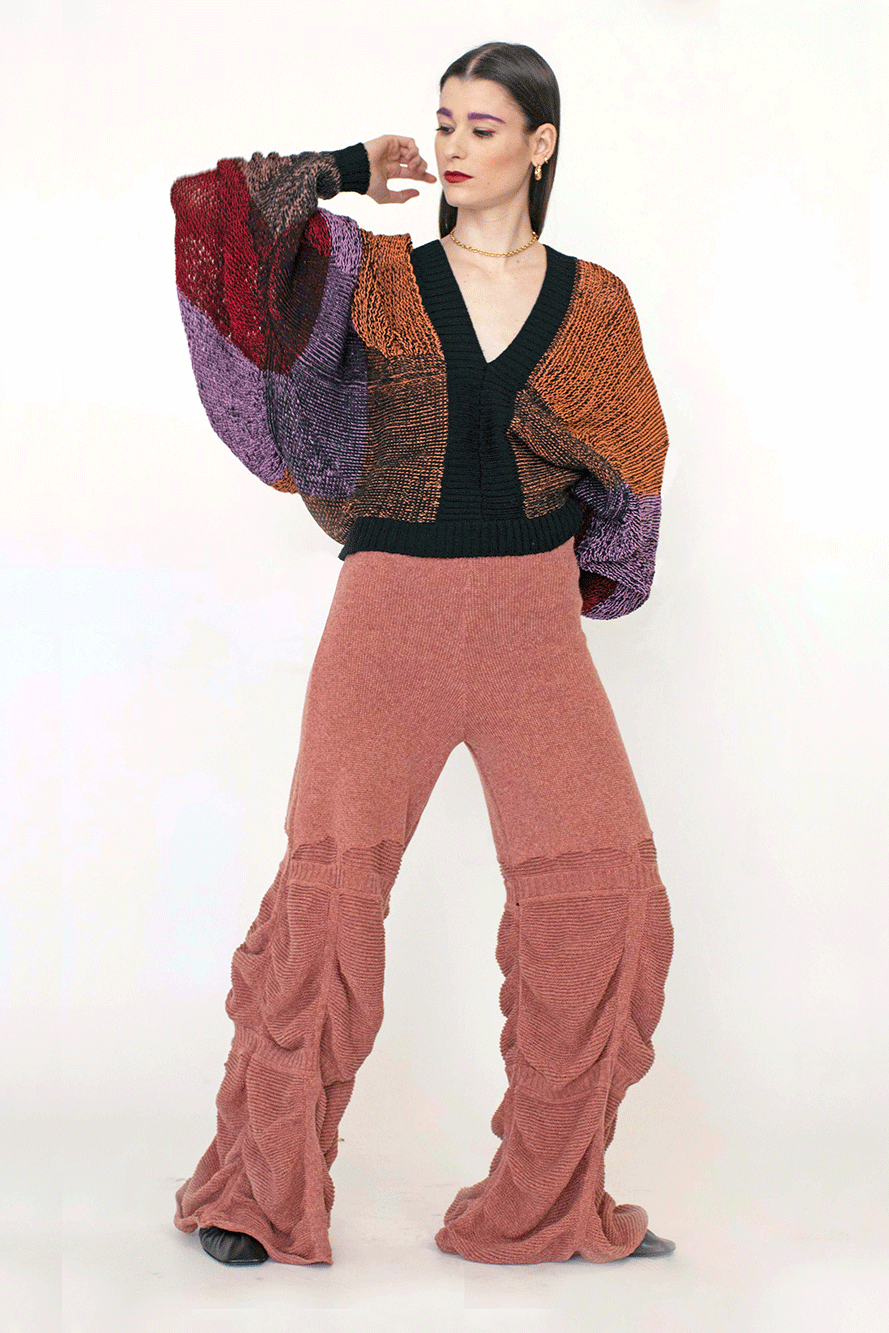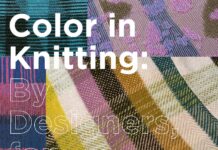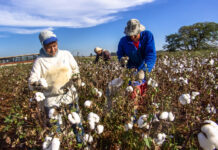It’s all in the technicalities of knitting for Milan based Knitwear Designer Rosalba Fucci. Since winning the Shima Seiki Europe 2021 Competition Royal College of Art MA Textiles Graduate Rosalba has pushed her innovative approach to knitwear design even further.
Self-professed “knit nerd” Rosa’s interests span fashion and knitted textiles, leading her to often question “Why isn’t everything knitted?!”.

© Arianna Genghini

© Arianna Genghini
“I would describe myself as a conceptual technical thinker: I like to challenge the technical aspects of knitting to create innovative and refined wearable pieces… I always strive to achieve smart and imaginative results by combining strong theoretical research with advanced fabric experimentation.”
Rosa’s graduate collection ‘knit-a-morphosis’ builds from the development of her Shima Seiki project, utilising the digital knitwear design skills that she learned whilst completing the training that she was awarded.
The collection
The 5 looks comprising Rosa’s collection instantly intrigue:
“Knit-a-morphosis is a knitwear collection composed of one-of-a-kind pieces that can be worn as they are but through an interaction with the wearer, can also irreversibly change in colour, shape, and volume, becoming more complex and exciting to wear.”
It is Rosa’s unique combinations of stitch structures which inform the silhouette and construction of each piece within the collection. Shaped entirely on the knitting machine, her pieces are plotted out, transforming experimentation into innovation.

© Arianna Genghini
Fabrics are interactive, and irreversibly customisable. Inviting consumer engagement with the garments, Rosa’s 8 garments can transform on the body, she explains, “Through a process of self-liberation of the wearer, these pieces develop becoming more colourful and voluminous. In other words, they take up more space, in response to a body that asks for more awareness to the clothes it is put in relation with”.

© Arianna Genghini
At the heart of this collection is a point of intrigue which captured Rosa’s attention at the start of her two year MA. Rebuilding what Rosa describes as “the lost connection between clothes, the wearers and their bodies” her practice explores the possibility of subverting existing hierarchies, letting the wearer take a leading position in relation to the garment. Rosa explains, “If usually clothes are shaping, correcting, and modifying the body, I asked myself: what if it was vice versa? Can the body engage with the garment instead of passively adapting to it?”.
“Clothes often leave marks on the body: what if the body left a mark on clothes instead?”

© Arianna Genghini
The changes that occur to these garments after pulling respective threads are irreversible. Discussing her take on this Rosa explained that she believes this dramatic decision invites risk and a sense of tension. To pull the thread and change the garment is an act of engagement from the wearer which must be considered – not underestimated. In this way, Rosa’s garments demand attention and consideration from the wearer, challenging them to choose their actions and live with the consequences.
This conceptual element of ‘knit-a-morphosis’ deepens this project and brings into focus consumer engagement between textiles and their bodies. Rosa’s collection poses the question “Could wearers feel more emotionally attached the product, delaying phycological obsolesce of the clothing?”.
Material choices
Keen to ensure her methods could work across a variety of material choices, Rosa explored many fibres and yarns in her initial phases of fabric development. Whilst the removable draw thread required a high breaking point to ensure it did not snap when pulled to ‘release’ the fabric, other fibre choices could be more universal.

© Arianna Genghini
With sponsorship for Loro Piana and English spinner Copley Marshall, Rosa was able to work with industry standard yarns to develop her final collection and achieve luxurious fabric handles, “Their yarns are classic but also extremely high quality, and this aligns perfectly with my design values and the vision I had of the collection”.
Facilitating the use of various gauges, Rosa chose to work with two counts of cashmere and one mercerized cotton quality, combined with Lora Piana’s ‘Stretchsilk’, “I chose this because this silk yarn combined with metal fibre has the function to help the transformed structures keep their volume and texture”.

© Arianna Genghini
Crucial to the element of surprise which Rosa’s collection captures is her use of colour. When the draw thread is pulled, stitches appear to unravel and beneath them unexpected combinations of vivid colour are revealed.
“During the transformation, the surprise element from a visual and tactile point of view is provided by the appearance of bright colours but also by the appearance of an unexpected yarn, the cell 3D from Be.mi.va, that creates a strong texture contrast with the base yarns”.
Craft vs technology
With much of her collection knitted digitally, it was crucial to gain an understanding from Rosa of how her love of the craft of knitting influences and strengthens her approach to digitalised making.
It is often the case that craft and technology can be at odds with one another. Detailing her appreciation for the cohesion of both, Rosa shared, “Of course, digital knitting machines offer more possibilities in terms of complexity, speed and precision, but sometimes hand flat machines can be fundamental to better understand a structure and/or for a more liberating and hands-on approach. I often find myself starting my experiments on the manual machines and then moving on to digital, not only to expand my design possibilities but also to translate my discoveries into an industrial production method”.
The process
Rosa’s collection was made without access to college facilities. Limited by the circumstances of the pandemic, Rosa secured sponsorship from Shima Seiki Italy for her digitally knitted garments, as well as participating in a remote collaboration with Loop Studio in London using Stoll machinery. This exposure to the use of Stoll and Shima Seiki production methods has been valuable to Rosa, building her understanding of the possibilities held within digital knitwear production. For the rest of her fabrics, Rosa carried out production using her domestic knitting machine at her home studio in Milan.
“These collaborations not only increased my digital knitting knowledge and my ability to professionally liaise with manufacturers but allowed me to make my knitwear collection become a reality”.
Rosa’s tenacity is admirable. When discussing the challenges she faced as an MA graduate during the pandemic she explained, “Working without the peer support system I was used to, isolated in my flat in Milan during lockdown has been a very challenging experience, but I also think it made me more resourceful and ready to face life and work challenges ahead”.

© Arianna Genghini
With ambitions to open her own knitwear consultancy studio after gaining more industry experience, Rosa can be confident she has the determination and skills to develop an exciting career, proven through her tenacity to problem solving her way through graduating in these terribly uncertain times.
We look forward to seeing what comes next for Rosa!
See Rosa’s collection
Rosa collaborated with friend and Fashion Photographer Arianna Genghini to create a short fashion performance film presenting the transformative process of the garments within the collection.
“Their metamorphosis is compared to the one from caterpillar to butterfly: the alternation of frames between the two evolutionary processes highlights their similarities and is accompanied by the verses from Ovid’s Metamorphoses Introduction.”
To see Rosa’s transformative fabrics in action, you can watch her fashion performance video and fabric interaction video, as well as visiting her website and Instagram platform.

© Arianna Genghini
Photography and production credits
Photographer – Arianna Genghini
Camera and light – Davide Carlini
Model – Cielo Fiordi
Makeup and hair – Sabrina Trentini

Subscribe To Our Newsletter
Join our mailing list to receive the latest news and updates from our team.














